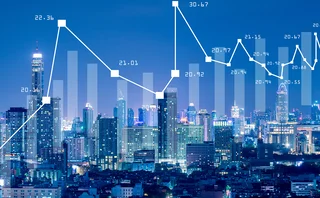
Quant unlocks the physics of the flash crash
The flash crash was statistically distinct from other market panics, and can be understood with a little help from the physics of supercool magnets
The flash crash in May this year was marked by persistent kurtosis levels, in contrast to most market panics where the measure drops, and can be modelled using the physics of spontaneous self-organization, says a top quant.
Lisa Borland, head of derivatives strategies at San Francisco-based hedge fund Evnine & Associates, has designed a model inspired by the physics of supercool magnets that captures this statistical signature.
"I was thinking of a panic as a kind of regime change, and it reminded me of spontaneous symmetry breaking in physics, when a system will undergo a phase transition and change many of its fundamental properties," she says.
In the model, stocks are likened to the particles in a magnet, and their upward or downward trend analogous to an intrinsic variable known as spin. At normal temperatures, these spins are distributed randomly within the magnet, but near absolute zero they align. In the analogy, the role of temperature is played by the inverse of volatility, so in a period of turmoil the stocks all move in the same direction, and hence exhibit strong correlation.
The key to the flash crash comes in the way the magnet is cooled – a uniform temperature decrease will yield a Gaussian return distribution, while concentrating the cooling effect will produce greater kurtosis. This corresponds to uniform and local volatility shocks respectively – with the latter case ideal for describing the flash crash's origin in one sudden batch of sell orders by high-frequency traders.
I was thinking of a panic as a kind of regime change, and it reminded me of spontaneous symmetry breaking in physics, when a system will undergo a phase transition and change many of its fundamental properties
A US Securities and Exchange Commission inquiry is due to report its findings on the flash crash by the end of September.
A more in-depth article on the model will appear in the October issue of Risk.
Only users who have a paid subscription or are part of a corporate subscription are able to print or copy content.
To access these options, along with all other subscription benefits, please contact info@risk.net or view our subscription options here: http://subscriptions.risk.net/subscribe
You are currently unable to print this content. Please contact info@risk.net to find out more.
You are currently unable to copy this content. Please contact info@risk.net to find out more.
Copyright Infopro Digital Limited. All rights reserved.
As outlined in our terms and conditions, https://www.infopro-digital.com/terms-and-conditions/subscriptions/ (point 2.4), printing is limited to a single copy.
If you would like to purchase additional rights please email info@risk.net
Copyright Infopro Digital Limited. All rights reserved.
You may share this content using our article tools. As outlined in our terms and conditions, https://www.infopro-digital.com/terms-and-conditions/subscriptions/ (clause 2.4), an Authorised User may only make one copy of the materials for their own personal use. You must also comply with the restrictions in clause 2.5.
If you would like to purchase additional rights please email info@risk.net
More on Market risk
Repo and FX markets buck year-end crunch fears
Price spike concerns ease as September’s surprise SOFR jump led to early preparations for bank window dressing
Market risk solutions 2023: market and vendor landscape
A Chartis Research report that examines the structural shifts in enterprise risk systems and the impact of regulations, as well as the available technology.
The new rules of market risk management
Amid 2020’s Covid-19-related market turmoil – with volatility and value-at-risk (VAR) measures soaring – some of the world’s largest investment banks took advantage of the extraordinary conditions to notch up record trading revenues. In a recent Risk.net…
ETF strategies to manage market volatility
Money managers and institutional investors are re-evaluating investment strategies in the face of rapidly shifting market conditions. Consequently, selective genres of exchange-traded funds (ETFs) are seeing robust growth in assets. Hong Kong Exchanges…
FRTB spurs data mining push at StanChart
Bank building “single golden source” of trade data in a bid to lower NMRF burden
Asian privacy laws obstruct FRTB data pooling efforts
Bank scepticism and regulatory hurdles likely to inhibit cross-border information sharing
Seizing the opportunity of transformational change
Sponsored Q&A: CompatibL, Murex and Numerix
Doubts grow over US FRTB implementation
Fragmented roll-out would price European banks “out of the market”







